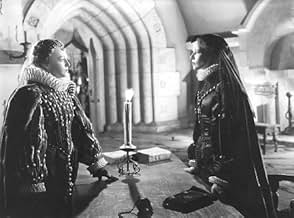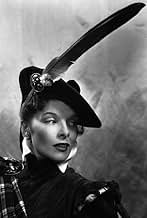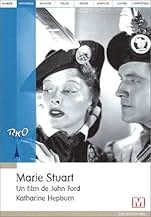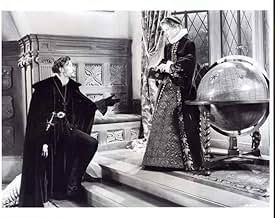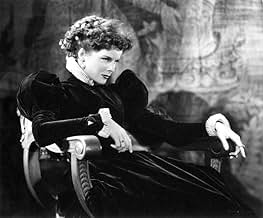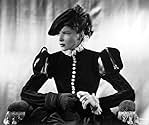IMDb RATING
6.3/10
2.9K
YOUR RATING
The recently widowed Mary Stuart returns to Scotland to reclaim her throne but is opposed by her half-brother and her own Scottish lords.The recently widowed Mary Stuart returns to Scotland to reclaim her throne but is opposed by her half-brother and her own Scottish lords.The recently widowed Mary Stuart returns to Scotland to reclaim her throne but is opposed by her half-brother and her own Scottish lords.
- Directors
- Writers
- Stars
- Awards
- 3 wins & 1 nomination total
- Directors
- Writers
- All cast & crew
- Production, box office & more at IMDbPro
Featured reviews
The complicated historical background involved in MARY OF Scotland is such that unless you know something about British monarchs you'll have a hard time knowing where the truth lies in this epic historical romance. But it's clear that KATHARINE HEPBURN gives a radiant performance as Mary, Queen of Scots--the only drawback being that she never ages a bit over a twenty-five year span. When she goes to her execution, she looks just as young as she did in the opening scene.
It's a pleasure to report that FREDRIC MARCH breathes a lot of life into his portrayal of Bothwell. Too bad he didn't exhibit this kind of gusto when he played the title role in ANTHONY ADVERSE the same year. He's all bravado and robust athletic grace and looks good in his period costumes. Maybe we owe his strong performance to John Ford, but whatever it is, he's much better here than he was as Anthony Adverse.
JOHN CARRADINE seemed an unusual choice to play Rizzo, the Italian secretary who happens to be a troubadour of sorts, but it's nice to see him in a more sympathetic role for a change. DONALD CRISP, ALAN MOBRAY, DOUGLAS WALTON and FRIEDA INESCOURT are interesting in supporting roles.
Walton is another actor who shines here, rather than remaining colorless in the background of many a film. He gives a flamboyant performance as Lord Darnley and it's probably among the best roles he ever had.
FLORENCE ELDRIDGE makes an interesting Queen Elizabeth, less showy in the role than Bette Davis or Flora Robson but still with the right amount of regal spirit.
John Ford directs the first half of the film with his usual authority but things get a little too repetitious and slow-moving in the second half when tedium really settles in before Mary's final walk to the execution block.
Summing up: A mixed bag, some strong performances, a few strong scenes but overall result is disappointing. Here's an historical romance that cried out for Technicolor. It manages to look drab in B&W despite the lavish costumes and good photography.
It's a pleasure to report that FREDRIC MARCH breathes a lot of life into his portrayal of Bothwell. Too bad he didn't exhibit this kind of gusto when he played the title role in ANTHONY ADVERSE the same year. He's all bravado and robust athletic grace and looks good in his period costumes. Maybe we owe his strong performance to John Ford, but whatever it is, he's much better here than he was as Anthony Adverse.
JOHN CARRADINE seemed an unusual choice to play Rizzo, the Italian secretary who happens to be a troubadour of sorts, but it's nice to see him in a more sympathetic role for a change. DONALD CRISP, ALAN MOBRAY, DOUGLAS WALTON and FRIEDA INESCOURT are interesting in supporting roles.
Walton is another actor who shines here, rather than remaining colorless in the background of many a film. He gives a flamboyant performance as Lord Darnley and it's probably among the best roles he ever had.
FLORENCE ELDRIDGE makes an interesting Queen Elizabeth, less showy in the role than Bette Davis or Flora Robson but still with the right amount of regal spirit.
John Ford directs the first half of the film with his usual authority but things get a little too repetitious and slow-moving in the second half when tedium really settles in before Mary's final walk to the execution block.
Summing up: A mixed bag, some strong performances, a few strong scenes but overall result is disappointing. Here's an historical romance that cried out for Technicolor. It manages to look drab in B&W despite the lavish costumes and good photography.
The life story of Mary, Queen of Scots is a thoroughly engaging one. I recommend anyone who wants to know more about the history while being entertained at the same time to check out the two Jean Plaidy books, ROYAL ROAD TO FOTHERINGAY and its sequel, THE CAPTIVE QUEEN OF SCOTS - two great little novels that tell you all there is to know.
MARY OF Scotland is an all-too Hollywoodised version of the story that suffers from an exceptionally overlong running time, unfortunately. It's strange, because some parts of the production are exceptionally slow and boring, while 19 years of history is condensed into about five minutes. There are a few eventful bits but for the most part this is a drag.
The director is none other than John Ford, but despite the presence of such a cinematic luminary, he seems uninterested in the material which is lifeless as a result. Katharine Hepburn is also a disappointment as Mary herself, singularly failing to make the queen sympathetic in any way. Fredric March does what he can as Bothwell, and there are nice little roles for John Carradine and Moroni Olsen, but it's not enough.
I particularly disliked the way that some good little bits of history are omitted or simplified for no apparent reason. For instance, Douglas Walton's final scene didn't happen that way at all and much more drama could have been made of it. Instead all the focus is on the talk and its incessant and goes nowhere. The definitive story of Mary, Queen of Scots this certainly isn't.
MARY OF Scotland is an all-too Hollywoodised version of the story that suffers from an exceptionally overlong running time, unfortunately. It's strange, because some parts of the production are exceptionally slow and boring, while 19 years of history is condensed into about five minutes. There are a few eventful bits but for the most part this is a drag.
The director is none other than John Ford, but despite the presence of such a cinematic luminary, he seems uninterested in the material which is lifeless as a result. Katharine Hepburn is also a disappointment as Mary herself, singularly failing to make the queen sympathetic in any way. Fredric March does what he can as Bothwell, and there are nice little roles for John Carradine and Moroni Olsen, but it's not enough.
I particularly disliked the way that some good little bits of history are omitted or simplified for no apparent reason. For instance, Douglas Walton's final scene didn't happen that way at all and much more drama could have been made of it. Instead all the focus is on the talk and its incessant and goes nowhere. The definitive story of Mary, Queen of Scots this certainly isn't.
This is a good costume-designing , historic-drama and Katherine Hepburn is well cast in the title role . She plays a tragic , romantic heroine that contends with various treacheries . Mary (1516-1558) inherited the throne of Scotland from Jacob V . She was next in line to the English kingdom , and married Francisco II , king of France , but he died early . Having been in France for thirteen years , Mary returned Scotland , and arrives from France with some misgivings . Then , Mary disembarks in Leith and goes to a castle near Edimburg , along with David Rizzio (a cadaverous John Carradine) , court musician and confidant . There , she's received by his brother , the Earl James Stuart , (Ian Keith) . Later on , Queen Mary married a foppish named Lord Darnley (Walton) . But Mary falls in love with Bothwell (a stylish Fredric March) , a kilted Earl and her supporter in her battle for power . Then , Rizzio was reputed to be the father of Mary's , the future James I of England . Darnley , with some underlings , murdered Rizzio in Mary's presence . But Darnley is killed by an explosion in his refuge , outskirts Edimburg , and the God-fearing Calvinists led by John Knox (Moroni Olsen who played same role in stage) accused to Bothwell as regicide . John Knox and the rebels Lords besiege Holyrood and the Borthwell's stronghold , Dumbar castle . The Calvinists forced her abdication , Mary escapes and asks for protection to Queen Elizabeth I (Florence Eldridge) , but Mary is double-crossed and is taken imprisoned in the Tower of London . Although supposedly Mary and Elizabeth never met face to face , the movie have them doing so and the screen crackle when both have their reunion , because they are strong rivals for power in Tudor dynasty , England . After that , Mary confronts her English accusers at court in a stylized trial . Finally , the film reflects splendidly when Mary goes to beheading block with all due pomp and circumstance .
The motion picture is finely performed by Katharine Hepburn, in spite of this she was in her ¨box-office poison¨ days , the last scenes , where Mary confronts trial is so well played and photographed in a stylized manner -with Mary on the floor and judges in a sort of balcony- by cameraman Joseph August . However , the picture is interminable and overlong and some moments is frankly boring . Writing credits with excessive speeches by Maxwell Anderson (his own playwright) and Dudley Nichols , a Ford's habitual screenwriter . The picture is lavishly produced by Pandro S. Berman , an usual costumer's producer and professionally directed by John Ford . Followed by a remake with the same title (1971) with Vanessa Redgrave as Mary and Glenda Jackson as Elizabeth and directed by Charles Jarrott .
The motion picture is finely performed by Katharine Hepburn, in spite of this she was in her ¨box-office poison¨ days , the last scenes , where Mary confronts trial is so well played and photographed in a stylized manner -with Mary on the floor and judges in a sort of balcony- by cameraman Joseph August . However , the picture is interminable and overlong and some moments is frankly boring . Writing credits with excessive speeches by Maxwell Anderson (his own playwright) and Dudley Nichols , a Ford's habitual screenwriter . The picture is lavishly produced by Pandro S. Berman , an usual costumer's producer and professionally directed by John Ford . Followed by a remake with the same title (1971) with Vanessa Redgrave as Mary and Glenda Jackson as Elizabeth and directed by Charles Jarrott .
Mary of Scotland (1935)
** 1/2 (out of 4)
Historical drama from RKO about the rivalry between Mary of Scots (Katharine Hepburn) and her cousin Elizabeth I (Florence Eldridge). The film follows Mary's fight for justice from 1560 to 1587 and includes her third marriage to Bothwell (Fredric March). This film was a notorious flop when it was originally released and it had a large part in Hepburn being called box office poison. Seeing the film today it's rather amazing to see how good the film actually looks considering RKO was usually just popping out very low-budget films. There were certainly a few exceptions and this here is one of them and I'm sure many will be shocked to see how much actually went into this film. The amazing sets and costumes are one of the biggest selling points to the movie. Ford knows how to make things appear epic and he does that here with these amazing sets that make you feel as if you're at the actual locations. Many times these sets are obviously on some lot but you never get that feeling here. The costumes are another major plus as they help bring a realistic nature to the film. I'm not sure what the actual budget was on the film but it really does look just as expensive as many of de Mille's epics. Another reason the film is worth viewing is the performance by Hepburn. As a devoted atheist she really does a nice job in the role of a Catholic and her religious scenes are quite moving as she's certainly giving it her all. She's very believable in the part as you can tell she's strong enough to lead all the battles that Mary had to. That strong nature of the actress clearly shows up on the screen. March is also very good in his role, although the film could have used much more of him. I was a little Luke warm on Eldridge but after a while she started to grow on me. The supporting cast includes Douglas Walton, Frieda Inescourt, Donald Crisp and John Carradine. Carradine plays the servant Rizzo and does a pretty good job with it. We also get to hear him sing a couple songs, which I'm not sure how many times he had the chance of doing that in his long career. The biggest problem with the movie is that the story is at times hard to follow as it appears like the screenplay wasn't totally sure where they wanted to take all of the events. I think at times the story just seemed to float all over the place.
** 1/2 (out of 4)
Historical drama from RKO about the rivalry between Mary of Scots (Katharine Hepburn) and her cousin Elizabeth I (Florence Eldridge). The film follows Mary's fight for justice from 1560 to 1587 and includes her third marriage to Bothwell (Fredric March). This film was a notorious flop when it was originally released and it had a large part in Hepburn being called box office poison. Seeing the film today it's rather amazing to see how good the film actually looks considering RKO was usually just popping out very low-budget films. There were certainly a few exceptions and this here is one of them and I'm sure many will be shocked to see how much actually went into this film. The amazing sets and costumes are one of the biggest selling points to the movie. Ford knows how to make things appear epic and he does that here with these amazing sets that make you feel as if you're at the actual locations. Many times these sets are obviously on some lot but you never get that feeling here. The costumes are another major plus as they help bring a realistic nature to the film. I'm not sure what the actual budget was on the film but it really does look just as expensive as many of de Mille's epics. Another reason the film is worth viewing is the performance by Hepburn. As a devoted atheist she really does a nice job in the role of a Catholic and her religious scenes are quite moving as she's certainly giving it her all. She's very believable in the part as you can tell she's strong enough to lead all the battles that Mary had to. That strong nature of the actress clearly shows up on the screen. March is also very good in his role, although the film could have used much more of him. I was a little Luke warm on Eldridge but after a while she started to grow on me. The supporting cast includes Douglas Walton, Frieda Inescourt, Donald Crisp and John Carradine. Carradine plays the servant Rizzo and does a pretty good job with it. We also get to hear him sing a couple songs, which I'm not sure how many times he had the chance of doing that in his long career. The biggest problem with the movie is that the story is at times hard to follow as it appears like the screenplay wasn't totally sure where they wanted to take all of the events. I think at times the story just seemed to float all over the place.
Brooks Atkinson was a first rate drama critic for the New York Times. He had blind spots. He over enthused on the career of Maxwell Anderson. Anderson wrote some good plays such as "Winterset", but Anderson was enthusiastic of Anderson's pompous attempts to do dramas in blank verse: "Mary Of Scotland", "Elizabeth The Queen", and "Anne Of The Thousand Days".
The problem with these plays is, even if they get the history right they are too stiff. Compare the conclusion of "Elizabeth The Queen" to "A Man For All Seasons". Yes, the loneliness of the elderly Elizabeth is shown as Essex goes to his doom - but in reality Elizabeth knew there were other young men to replace her dangerous, ambitious lover. In "All Seasons" the tragedy of a rotten system crushing the life of a decent, thoughtful man like Thomas More is far more powerful as it's stark tragedy is silently brought to us.
That said, the first of the three Tudor tragedies to be filmed was "Mary Of Scotland". It is above average because it is starring Katherine Hepburn (a distant relative of Mary's third husband the Earl of Bothwell) and Frederic March, and directed wholly or partially by John Ford. It suffers from being black and white, except for one moment of sheer unexpected terror: when Mary sees the Scots nobles who oppose her they are photographed in such light and darkness to look like ogres in a nightmare.
The film follows the reign of Mary from 1560 to her execution in 1587. Most Americans do not understand the great difficulties that Mary (and Elizabeth) both faced in their parallel reigns. While England and Scotland allowed for female monarchs, women were not considered good material for rulers. They were considered governed by their emotions more than by their brains. Those women who ruled well were usually married to capable partners (Isabella of Castille and Ferdinand of Aragon of Spain). More frequently they were dismissed as misfits, like Isabella and Ferdinand's daughter Juana the Mad).
Mary had other problems. From 1400 to 1560 the nobles of Scotland got a great boon. Scotland had a series of minors who grew up to be king, married, and then died before they could cement their monarchic views on the government. The nobles cemented their local powers at the expense of a weak central authority.
Mary had been Queen of France, married to Francis II who ruled for a two year period (1559 - 1560). As Mary was the niece of the Duc De Guise, the king's power-hungry mother Catherine De Medici hated her. When Francis died suddenly, Catherine encouraged Mary to return to rule her own country. Surprised Mary did so, not realizing that she was unprepared to start ruling. She was a Catholic, and she really needed some time to understand the need to compromise and take advice from Protestants. She never did understand this.
Her foes hated her and were fully supported by Elizabeth, who never could see that an attempt to join forces with her cousin might pay back great dividends. But then Mary was ambitious - she wanted to be Queen of England as well as Scotland. Her Catholic supporters felt she was legitimate Queen of England (as Henry VIII had briefly disowned Elizabeth as a bastard when he executed her mother Anne). So the peaceful resolution of their differences was almost impossible.
Elizabeth had only to watch from the sidelines, with only an occasional move on her own part, to see Mary wreck her own position. She encouraged a marriage between another cousin/potential heir Lord Henry Darnley to Mary (Mary almost chose Elizabeth's lover Robert Dudley!). The marriage was a disaster, as Darnley was an ambitious fool and vicious scoundrel. But it cemented a Scottish succession to the British throne from two Tudor heirs instead of one.
Hepburn portrays Mary as a brave woman desperately seeking a way out of the difficult situation she has inherited, especially tied to Darnley by marriage and facing the ghouls who are John Knox (Moroni Olsen) and the Scottish nobles - led by her jealous half brother the Earl of Moray (Ian Keith). Her only allies are the independent Earl of Bothwell (March) and her secretary Rizzio (John Carridine). The murder of the latter (implicating Darnley) is the first step to her loss of the throne, and to the death of her husband. We know today that Kirk'a'Field house was blown up by Bothwell, but to this day we don't know if Mary was implicated. It remains one of the big mysteries of the 16th Century.
Historically Bothwell was no prince, but ambitious in his own right - he killed Darnley in order to marry Mary, and guide her to rule both Scotland and England. But March plays him as a man deeply in love with his Queen, and this enhances the story's tragedy - especially as Bothwell died in exile insane. The reason for this was his ship was captured by a Danish warship. Bothwell was guilty of a rape in Denmark, and was imprisoned. His punishment (which led to his madness) was to stand chained to a stone pillar that was half his height.
The last ten minutes glosses over the road that led Mary to the block in England - her support of a plot by one Anthony Babbington to kill Elizabeth and let Mary take the throne. Elizabeth's spy-master Sir Francis Walsingham sprung this trap - though Elizabeth did not reject the result. Elizabeth allowed a functionary to be blamed for falsely getting her to sign the death warrant - but all she did was briefly imprison the man. Unlike her movie representative (Florence Eldritch) she never met Mary.
A good film - but it is too gentle on Mary's failings, and not deep enough to explain what is going on in the background.
The problem with these plays is, even if they get the history right they are too stiff. Compare the conclusion of "Elizabeth The Queen" to "A Man For All Seasons". Yes, the loneliness of the elderly Elizabeth is shown as Essex goes to his doom - but in reality Elizabeth knew there were other young men to replace her dangerous, ambitious lover. In "All Seasons" the tragedy of a rotten system crushing the life of a decent, thoughtful man like Thomas More is far more powerful as it's stark tragedy is silently brought to us.
That said, the first of the three Tudor tragedies to be filmed was "Mary Of Scotland". It is above average because it is starring Katherine Hepburn (a distant relative of Mary's third husband the Earl of Bothwell) and Frederic March, and directed wholly or partially by John Ford. It suffers from being black and white, except for one moment of sheer unexpected terror: when Mary sees the Scots nobles who oppose her they are photographed in such light and darkness to look like ogres in a nightmare.
The film follows the reign of Mary from 1560 to her execution in 1587. Most Americans do not understand the great difficulties that Mary (and Elizabeth) both faced in their parallel reigns. While England and Scotland allowed for female monarchs, women were not considered good material for rulers. They were considered governed by their emotions more than by their brains. Those women who ruled well were usually married to capable partners (Isabella of Castille and Ferdinand of Aragon of Spain). More frequently they were dismissed as misfits, like Isabella and Ferdinand's daughter Juana the Mad).
Mary had other problems. From 1400 to 1560 the nobles of Scotland got a great boon. Scotland had a series of minors who grew up to be king, married, and then died before they could cement their monarchic views on the government. The nobles cemented their local powers at the expense of a weak central authority.
Mary had been Queen of France, married to Francis II who ruled for a two year period (1559 - 1560). As Mary was the niece of the Duc De Guise, the king's power-hungry mother Catherine De Medici hated her. When Francis died suddenly, Catherine encouraged Mary to return to rule her own country. Surprised Mary did so, not realizing that she was unprepared to start ruling. She was a Catholic, and she really needed some time to understand the need to compromise and take advice from Protestants. She never did understand this.
Her foes hated her and were fully supported by Elizabeth, who never could see that an attempt to join forces with her cousin might pay back great dividends. But then Mary was ambitious - she wanted to be Queen of England as well as Scotland. Her Catholic supporters felt she was legitimate Queen of England (as Henry VIII had briefly disowned Elizabeth as a bastard when he executed her mother Anne). So the peaceful resolution of their differences was almost impossible.
Elizabeth had only to watch from the sidelines, with only an occasional move on her own part, to see Mary wreck her own position. She encouraged a marriage between another cousin/potential heir Lord Henry Darnley to Mary (Mary almost chose Elizabeth's lover Robert Dudley!). The marriage was a disaster, as Darnley was an ambitious fool and vicious scoundrel. But it cemented a Scottish succession to the British throne from two Tudor heirs instead of one.
Hepburn portrays Mary as a brave woman desperately seeking a way out of the difficult situation she has inherited, especially tied to Darnley by marriage and facing the ghouls who are John Knox (Moroni Olsen) and the Scottish nobles - led by her jealous half brother the Earl of Moray (Ian Keith). Her only allies are the independent Earl of Bothwell (March) and her secretary Rizzio (John Carridine). The murder of the latter (implicating Darnley) is the first step to her loss of the throne, and to the death of her husband. We know today that Kirk'a'Field house was blown up by Bothwell, but to this day we don't know if Mary was implicated. It remains one of the big mysteries of the 16th Century.
Historically Bothwell was no prince, but ambitious in his own right - he killed Darnley in order to marry Mary, and guide her to rule both Scotland and England. But March plays him as a man deeply in love with his Queen, and this enhances the story's tragedy - especially as Bothwell died in exile insane. The reason for this was his ship was captured by a Danish warship. Bothwell was guilty of a rape in Denmark, and was imprisoned. His punishment (which led to his madness) was to stand chained to a stone pillar that was half his height.
The last ten minutes glosses over the road that led Mary to the block in England - her support of a plot by one Anthony Babbington to kill Elizabeth and let Mary take the throne. Elizabeth's spy-master Sir Francis Walsingham sprung this trap - though Elizabeth did not reject the result. Elizabeth allowed a functionary to be blamed for falsely getting her to sign the death warrant - but all she did was briefly imprison the man. Unlike her movie representative (Florence Eldritch) she never met Mary.
A good film - but it is too gentle on Mary's failings, and not deep enough to explain what is going on in the background.
Did you know
- TriviaKatharine Hepburn is a distant relative of the Earl of Bothwell, whose family name was Hepburn.
- GoofsMary's execution takes place outdoors. It actually took place in the great hall of Fotheringay Castle.
- Quotes
Mary, Queen of Scots: [to Queen Elizabeth I] I might have known you'd come to gloat like this - stealthily, under cover of night.
- Crazy creditsOpening credits: "Like two fateful stars, Mary Stuart and Elizabeth Tudor appeared in the sixteenth century, to reign over two great nations in the making ... They were doomed to a life-and-death struggle for supremacy, a lurid struggle that still shines across the pages of history ... But today, after more than three centuries, they sleep side by side, at peace, in Westminster Abbey."
ENGLAND
- Alternate versionsExists in a computer-colorized version.
- ConnectionsFeatured in The Costume Designer (1950)
Details
- Release date
- Country of origin
- Language
- Also known as
- María Estuardo, reina de Escocia
- Filming locations
- Production company
- See more company credits at IMDbPro
- Runtime2 hours 3 minutes
- Color
- Aspect ratio
- 1.37 : 1
Contribute to this page
Suggest an edit or add missing content



